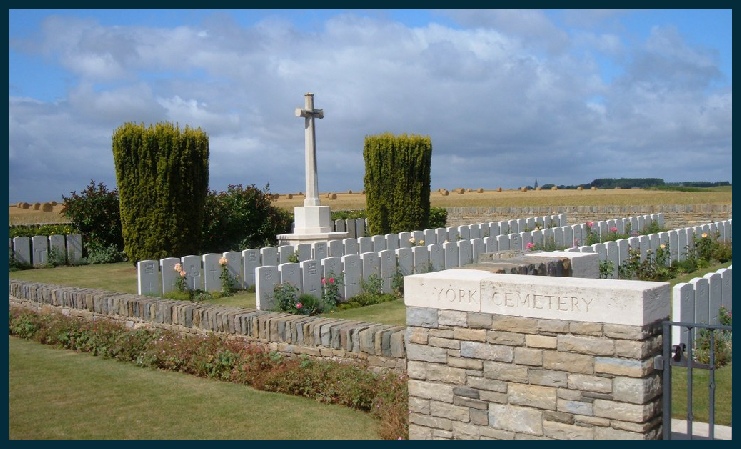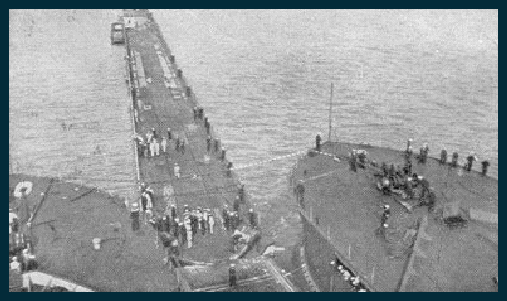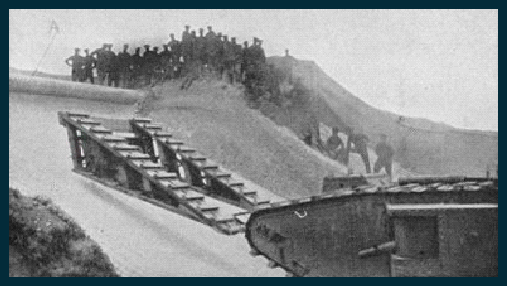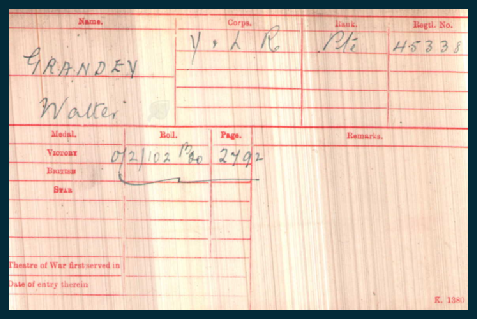Copyright © All rights reserved.



Walter Grandy

Walter Grandy (sometimes spelt Grandey) was born in the third quarter of 1898 and his birth registered in Malton. He was the third son of William and Edith Ruddock (nee Fell) Grandy who married in the first quarter of 1890 in the Malton area.
In 1901 William was working as a porter and, together with Edith and their six children, was living with Edith’s elderly parents at 48 Greengate.
1901 census-
RUDDOCK, John, Head, Married, M, 75, Pensioner On Railway, Malton Yorkshire,
RUDDOCK, Charlotte, Wife, Married, F, 76, , Malton Yorkshire,
GRANDY, William, Son-
GRANDY, Edith, Daughter, Married, F, 39, , Malton Yorkshire,
GRANDY, John William, Grand Son, Single, M, 9, , Malton Yorkshire,
GRANDY, Lily, Grand Daughter, Single, F, 7, , Malton Yorkshire,
GRANDY, Joseph, Grand Son, Single, M, 6, , Malton Yorkshire,
GRANDY, Walter, Grand Son, Single, M, 2, , Malton Yorkshire,
GRANDY, Edith, Grand Daughter, Single, F, 0 (9 MOS), , Malton Yorkshire
By 1911 they had taken over the house, after the deaths of Edith’s parents in 1902 and 1909. Walter was still at school, but also earning money as a milk boy. He also sang in the choir at St Leonard’s Church.
1911 census – resident at 48 Greengate
GRANDEY, William, Head, Married, M, 50 , Bricklayers Labourer, Yorks Malton,
GRANDEY, Edith, Wife, Married 21 years, F, 49 , , Yorks Malton,
GRANDEY, John William, Son, Single, M, 19 , Apprentice Cycle And Motor Trade, Yorks Malton,
GRANDEY, Lilly, Daughter, Single, F, 17 , , Yorks Malton,
GRANDEY, Joseph, Son, Single, M, 16 , Errand Boy, Yorks Malton,
GRANDEY, Walter, Son, , M, 12 , School Milk Boy, Yorks Malton,
GRANDEY, Edith Rebbeca, Daughter, , F, 10 , School, Yorks Malton,
Walter enlisted in the 1/4th (Hallamshire) Battalion of the York and Lancaster Regiment in Malton. This battalion was a territorial battalion raised in Sheffield in August 1914 as part of 3rd West Riding Brigade, West Riding Division. In February 1915 they were moved to York, which is presumably when Walter enlisted. In April 1915 they landed at Boulogne and the formation became 148th Brigade in 49th (West Riding) Division.
In October the division took part in the Battle of Poelcapelle, an action that marked the end of the string of highly successful British attacks in late September and early October 1917, during the Third Battle of Ypres. Only the supporting attack in the north achieved a substantial advance. On the main front the German defences withstood the limited amount of artillery fire achieved by the British after the attack of 4 October. The ground along the main ridges had been severely damaged by artillery fire and rapidly deteriorated in the rains, which began again on 3 October. In some areas the ground became a swamp. Dreadful ground conditions had more effect on the British, who needed to move forward large amounts of artillery and ammunition to support the next attack. The battle was a defensive success for the German army, although costly to both sides. The weather and ground conditions put severe strain on all the infantry involved and led to many wounded being stranded on the battlefield. Early misleading information and delays in communication led Plumer and Haig to plan the next attack (the First Battle of Passchendaele) under the impression that a substantial advance had taken place.
During 1918 the division took part in the Battles of the Lys,part of the 1918 German offensive in Flanders also known as the Spring Offensive. It was originally planned by General Ludendorff as Operation George but reduced to become Operation Georgette, with the objective of capturing Ypres and forcing the British forces back to the Channel ports (and thereby out of the war). The battles began on 7 April 1918, and lasted until 29 April. They included the Battle of Estaires, the battle of Messines, the battle of Bailleul in which the Division defended Neuve Eglise, the two battles of Kemmel Ridge and the battle of the Scherpenberg. Later that year they were involved in the pursuit to the Selle. The Fourth Army spearheaded a rapid advance of over 8 miles on 9-
As part of an effort by Third Army/V Corps/33rd and 17th Divisions to carry the Selle River on 10th October, they were engaged in house-
It was during this drive forwards that Walter Grandey was killed. He was buried in York Cemetery in Haspres which was created, at the end of October 1918, by the 1st/5th York and Lancaster Regiment and other units of the 49th (West Riding) Division.
Walter is commemorated on the Town Memorial and in St Leonard's Church.
The Division remained in France and Flanders and that year took part in the Battle of Aubers Ridge (9 May) and the defence against the first Phosgene attack. 1916 was spent on the Somme. Early in 1917, in order to counter the German threat to British naval supremacy, Admiral Sir Reginald Bacon proposed that an amphibious landing should be made on the Belgian coast, supported by a breakout attack from Nieuport and the Yser bridgehead. This was called Operation Hush.
Planning for the landings began almost immediately. Three huge pontoons, each 700 feet long, were built to accommodate the landing forces, which included 13,750 men from the 1st Division, with supporting artillery, tanks, motor machine guns, cyclists and trench mortar batteries. Each pontoon was pushed along by two monitors,which were also tasked with attacking shore positions during the landing. Aerial photographs and submarine sorties were used to map the profile of the beaches. This information was used to shape the hulls of the pontoons, so that they would slide easily up the beaches and get as close to the sea wall as possible. The whole landing was to be screened with smoke from eighty boats, each with three burners, and a total of fifty tons of phosphorus.
Training for the landings took place in great secrecy. The plan for Operation Hush became an integral part of the thinking that eventually took the form of the Third Battle of Ypres. This attack, which was eventually launched on 31 July 1917, was aimed initially at capturing and clearing the Belgian coast. Once forces had broken through the German defences at Ypres, the landings would take place.
On 22 May 1917, Sir Douglas Haig gave Sir Henry Rawlinson command of the coastal sector of operations. He placed his HQ at Malo-


